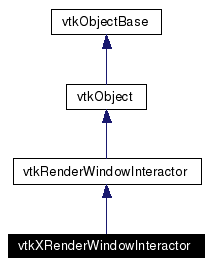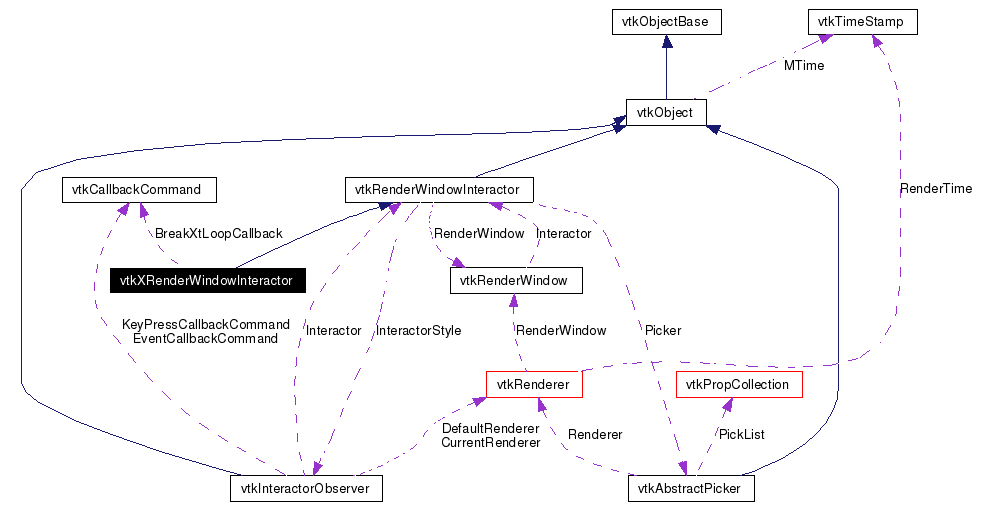
#include <vtkXRenderWindowInteractor.h>
Inheritance diagram for vtkXRenderWindowInteractor:


vtkXRenderWindowInteractor is a convenience object that provides event bindings to common graphics functions. For example, camera and actor functions such as zoom-in/zoom-out, azimuth, roll, and pan. IT is one of the window system specific subclasses of vtkRenderWindowInteractor. Please see vtkRenderWindowInteractor documentation for event bindings.
Definition at line 56 of file vtkXRenderWindowInteractor.h.
| virtual void | GetMousePosition (int *x, int *y) |
| void | vtkXRenderWindowInteractorCallback (Widget, XtPointer, XEvent *, Boolean *) |
| void | vtkXRenderWindowInteractorTimer (XtPointer, XtIntervalId *) |
Public Types | |
| typedef vtkRenderWindowInteractor | Superclass |
Public Member Functions | |
| virtual const char * | GetClassName () |
| virtual int | IsA (const char *type) |
| void | PrintSelf (ostream &os, vtkIndent indent) |
| virtual void | Initialize () |
| void | TerminateApp (void) |
| virtual void | SetBreakLoopFlag (int) |
| virtual int | GetBreakLoopFlag () |
| virtual void | BreakLoopFlagOn () |
| virtual void | BreakLoopFlagOff () |
| int | CreateTimer (int timertype) |
| int | DestroyTimer (void) |
| virtual void | Initialize (XtAppContext app) |
| virtual XtAppContext | GetApp () |
| virtual void | Enable () |
| virtual void | Disable () |
| virtual void | Start () |
| virtual void | SetWidget (Widget) |
| Widget | GetWidget () |
| virtual void | SetTopLevelShell (Widget) |
| Widget | GetTopLevelShell () |
Static Public Member Functions | |
| static vtkXRenderWindowInteractor * | New () |
| static int | IsTypeOf (const char *type) |
| static vtkXRenderWindowInteractor * | SafeDownCast (vtkObject *o) |
Protected Member Functions | |
| vtkXRenderWindowInteractor () | |
| ~vtkXRenderWindowInteractor () | |
| XtIntervalId | AddTimeOut (XtAppContext app_context, unsigned long interval, XtTimerCallbackProc proc, XtPointer client_data) |
| void | Timer (XtPointer client_data, XtIntervalId *id) |
| void | Callback (Widget w, XtPointer client_data, XEvent *event, Boolean *ctd) |
Static Protected Member Functions | |
| static void | BreakXtLoop (vtkObject *, unsigned long, void *, void *) |
Protected Attributes | |
| Display * | DisplayId |
| Window | WindowId |
| Atom | KillAtom |
| Widget | Top |
| int | OwnTop |
| int | OwnApp |
| int | PositionBeforeStereo [2] |
| Widget | TopLevelShell |
| int | BreakLoopFlag |
| vtkCallbackCommand * | BreakXtLoopCallback |
Static Protected Attributes | |
| static XtAppContext | App |
| static int | NumAppInitialized |
|
|
Reimplemented from vtkRenderWindowInteractor. Definition at line 60 of file vtkXRenderWindowInteractor.h. |
|
|
|
|
|
|
|
|
Create an object with Debug turned off, modified time initialized to zero, and reference counting on. Reimplemented from vtkRenderWindowInteractor. |
|
|
Reimplemented from vtkRenderWindowInteractor. |
|
|
Return 1 if this class type is the same type of (or a subclass of) the named class. Returns 0 otherwise. This method works in combination with vtkTypeRevisionMacro found in vtkSetGet.h. Reimplemented from vtkRenderWindowInteractor. |
|
|
Return 1 if this class is the same type of (or a subclass of) the named class. Returns 0 otherwise. This method works in combination with vtkTypeRevisionMacro found in vtkSetGet.h. Reimplemented from vtkRenderWindowInteractor. |
|
|
Reimplemented from vtkRenderWindowInteractor. |
|
||||||||||||
|
Methods invoked by print to print information about the object including superclasses. Typically not called by the user (use Print() instead) but used in the hierarchical print process to combine the output of several classes. Reimplemented from vtkRenderWindowInteractor. |
|
|
Initializes the event handlers without an XtAppContext. This is good for when you don't have a user interface, but you still want to have mouse interaction. Reimplemented from vtkRenderWindowInteractor. |
|
|
Call exit on 'q','e' keypress. Want more ??? Reimplemented from vtkRenderWindowInteractor. Definition at line 69 of file vtkXRenderWindowInteractor.h. |
|
|
The BreakLoopFlag is checked in the Start() method. Setting it to anything other than zero will cause the interactor loop to terminate and return to the calling function. |
|
|
Call exit on 'q','e' keypress. Want more ??? |
|
|
Call exit on 'q','e' keypress. Want more ??? |
|
|
Call exit on 'q','e' keypress. Want more ??? |
|
|
X timer methods Reimplemented from vtkRenderWindowInteractor. |
|
|
X timer methods Reimplemented from vtkRenderWindowInteractor. |
|
|
Initializes the event handlers using an XtAppContext that you have provided. This assumes that you want to own the event loop. |
|
|
Initializes the event handlers using an XtAppContext that you have provided. This assumes that you want to own the event loop. |
|
|
Enable/Disable interactions. By default interactors are enabled when initialized. Initialize() must be called prior to enabling/disabling interaction. These methods are used when a window/widget is being shared by multiple renderers and interactors. This allows a "modal" display where one interactor is active when its data is to be displayed and all other interactors associated with the widget are disabled when their data is not displayed. Reimplemented from vtkRenderWindowInteractor. |
|
|
Enable/Disable interactions. By default interactors are enabled when initialized. Initialize() must be called prior to enabling/disabling interaction. These methods are used when a window/widget is being shared by multiple renderers and interactors. This allows a "modal" display where one interactor is active when its data is to be displayed and all other interactors associated with the widget are disabled when their data is not displayed. Reimplemented from vtkRenderWindowInteractor. |
|
|
This will start up the X event loop and never return. If you call this method it will loop processing X events until the application is exited. Reimplemented from vtkRenderWindowInteractor. |
|
|
Specify the Xt widget to use for interaction. This method is one of a couple steps that are required for setting up a vtkRenderWindowInteractor as a widget inside of another user interface. You do not need to use this method if the render window will be a stand-alone window. This is only used when you want the render window to be a subwindow within a larger user interface. In that case, you must tell the render window what X display id to use, and then ask the render window what depth, visual and colormap it wants. Then, you must create an Xt TopLevelShell with those settings. Then you can create the rest of your user interface as a child of the TopLevelShell you created. Eventually, you will create a drawing area or some other widget to serve as the rendering window. You must use the SetWidget method to tell this Interactor about that widget. It's X and it's not terribly easy, but it looks cool. |
|
|
This will start up the X event loop and never return. If you call this method it will loop processing X events until the application is exited. Definition at line 126 of file vtkXRenderWindowInteractor.h. |
|
|
This method will store the top level shell widget for the interactor. This method and the method invocation sequence applies for: 1 vtkRenderWindow-Interactor pair in a nested widget hierarchy multiple vtkRenderWindow-Interactor pairs in the same top level shell It is not needed for 1 vtkRenderWindow-Interactor pair as the direct child of a top level shell multiple vtkRenderWindow-Interactor pairs, each in its own top level shell The method, along with EnterNotify event, changes the keyboard focus among the widgets/vtkRenderWindow(s) so the Interactor(s) can receive the proper keyboard events. The following calls need to be made: vtkRenderWindow's display ID need to be set to the top level shell's display ID. vtkXRenderWindowInteractor's Widget has to be set to the vtkRenderWindow's container widget vtkXRenderWindowInteractor's TopLevel has to be set to the top level shell widget note that the procedure for setting up render window in a widget needs to be followed. See vtkRenderWindowInteractor's SetWidget method. If multiple vtkRenderWindow-Interactor pairs in SEPARATE windows are desired, do not set the display ID (Interactor will create them as needed. Alternatively, create and set distinct DisplayID for each vtkRenderWindow. Using the same display ID without setting the parent widgets will cause the display to be reinitialized every time an interactor is initialized), do not set the widgets (so the render windows would be in their own windows), and do not set TopLevelShell (each has its own top level shell already) |
|
|
This method will store the top level shell widget for the interactor. This method and the method invocation sequence applies for: 1 vtkRenderWindow-Interactor pair in a nested widget hierarchy multiple vtkRenderWindow-Interactor pairs in the same top level shell It is not needed for 1 vtkRenderWindow-Interactor pair as the direct child of a top level shell multiple vtkRenderWindow-Interactor pairs, each in its own top level shell The method, along with EnterNotify event, changes the keyboard focus among the widgets/vtkRenderWindow(s) so the Interactor(s) can receive the proper keyboard events. The following calls need to be made: vtkRenderWindow's display ID need to be set to the top level shell's display ID. vtkXRenderWindowInteractor's Widget has to be set to the vtkRenderWindow's container widget vtkXRenderWindowInteractor's TopLevel has to be set to the top level shell widget note that the procedure for setting up render window in a widget needs to be followed. See vtkRenderWindowInteractor's SetWidget method. If multiple vtkRenderWindow-Interactor pairs in SEPARATE windows are desired, do not set the display ID (Interactor will create them as needed. Alternatively, create and set distinct DisplayID for each vtkRenderWindow. Using the same display ID without setting the parent widgets will cause the display to be reinitialized every time an interactor is initialized), do not set the widgets (so the render windows would be in their own windows), and do not set TopLevelShell (each has its own top level shell already) Definition at line 155 of file vtkXRenderWindowInteractor.h. |
|
||||||||||||
|
Re-defines virtual function to get mouse position by querying X-server. Reimplemented from vtkRenderWindowInteractor. |
|
||||||||||||||||||||
|
|
|
||||||||||||
|
|
|
||||||||||||||||||||
|
|
|
||||||||||||||||||||
|
|
|
||||||||||||||||||||
|
Functions that are used internally. |
|
||||||||||||
|
Re-defines virtual function to get mouse position by querying X-server. |
|
|
Definition at line 174 of file vtkXRenderWindowInteractor.h. |
|
|
Definition at line 175 of file vtkXRenderWindowInteractor.h. |
|
|
Definition at line 177 of file vtkXRenderWindowInteractor.h. |
|
|
Definition at line 178 of file vtkXRenderWindowInteractor.h. |
|
|
Definition at line 179 of file vtkXRenderWindowInteractor.h. |
|
|
Definition at line 180 of file vtkXRenderWindowInteractor.h. |
|
|
Definition at line 181 of file vtkXRenderWindowInteractor.h. |
|
|
Definition at line 182 of file vtkXRenderWindowInteractor.h. |
|
|
Definition at line 183 of file vtkXRenderWindowInteractor.h. |
|
|
Definition at line 184 of file vtkXRenderWindowInteractor.h. |
|
|
Definition at line 186 of file vtkXRenderWindowInteractor.h. |
|
|
Definition at line 192 of file vtkXRenderWindowInteractor.h. |
 1.4.3-20050530
1.4.3-20050530